
Heterocrossa adreptella is a moth of the Carposinidae family. This species was long considered the New Zealand raspberry budmoth however this was a taxonomic misinterpretation of the type material used to describe this species. This error was corrected in 1988 with the New Zealand raspberry budmoth giving its own species name Heterocrossa rubophaga. H. adreptella is endemic to New Zealand and has been collected in the Wellington Botanic Garden and been observed resting on mānuka branches.
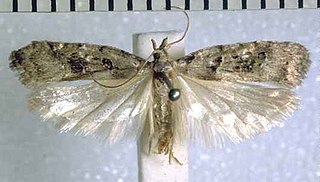
Heterocrossa canescens is a species of moth in the family Carposinidae. It is endemic to New Zealand. This species has been observed in Aoraki / Mount Cook National Park and in the Southern Alps. The larvae of this species feed on the fruits and flowers of endemic to New Zealand species in the genus Gaultheria. Adult moths are on the wing in November and from January to March.

Heterocrossa contactella is a species of moth in the family Carposinidae. It is endemic to New Zealand and can be observed in both the North and South Islands. The preferred habitat of this species is native forest and scrub, especially where Leptospermum shrubs are found. Adults are on the wing in December and January.

Heterocrossa epomiana is a species moth in the family Carposinidae. It is endemic to New Zealand and has been observed in Westland. Adults are on the wing in January. This species is visually very similar to H. gonosemana and to H. philpotti.

Heterocrossa exochana is a species of moth in the family Carposinidae. It is endemic to New Zealand and has been observed in the North and South Islands. The larvae of this species feed on the fruits of Muehlenbeckia species. The adult is on the wing from September until May and are attracted to light.

Heterocrossa gonosemana is a species of moth in the family Carposinidae. It is endemic to New Zealand and is found throughout the country. It inhabits native forest. Larvae feed on seeds and fruit of Griselinia lucida and possibly Griselinia littoralis. They can be extremely active when disturbed. This species overwinters as a pupa, enclosed in a cocoon, underneath its host plant. Adults are on the wing from November until February and can be found during the day resting on lichen covered tree trunks where they are well camouflaged. The adult is nocturnal and is attracted to light.
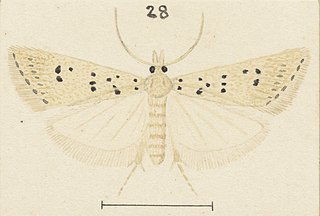
Heterocrossa maculosa is a species of moth in the family Carposinidae. It is endemic to New Zealand. It is classified as "Data Deficient" by the Department of Conservation.

Heterocrossa sarcanthes is a moth of the Carposinidae family first described by Edward Meyrick in 1918. It is endemic to New Zealand and has been observed in Wellington. The adults of this species is similar in appearance to H. adreptella but can be distinguished from that species as H. sarcanthes has a pale pinkish-ochreous colour to the basal half of the hindwings.
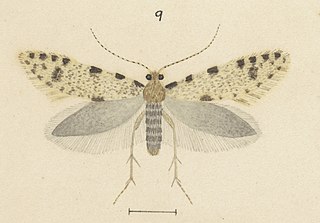
Reductoderces cawthronella is a moth of the Psychidae family. It was described by Alfred Philpott in 1921 and named in honour of the Cawthron Institute. It is endemic to New Zealand and has been collected in Nelson on the Maitai Valley side of the Botanical Hill. The larvae inhabits a fragile, pear shaped case and it has been hypothesised that they are lichen or alga browsers. Larvae pupate at the end of June and adults emerge at the beginning of August until the middle of October.
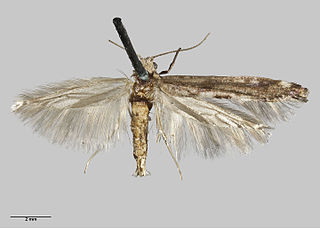
Zelleria maculata is a moth species of the family Yponomeutidae. This species was described by Alfred Philpott in 1930. It is endemic to New Zealand and is found on both the North and South Islands. This species inhabits native forest and prefers interior rather than edge habitat. Larvae feed on species of endangered mistletoe, including Peraxilla tetrapetala and Peraxilla colensoi, first by mining their leaves and then by consuming parts of flowers or leaves. By feeding on flower parts Z. maculata larvae affect the production of seeds of its endangered hosts. Adults are on the wing from August until February and likely have one brood a year. Adult moths rest in a steep angled head down tail up posture. A parasitic wasp in the genus Campoplex predates the larvae of Z. maculata.

Anisoplaca fraxinea is a species of moth of the family Gelechiidae. It was described by Alfred Philpott in 1928 and is endemic to New Zealand. It has been observed in the South Island and adults are on the wing in February and March.

Asaphodes albalineata is a species of moth in the family Geometridae. It is endemic to New Zealand and has been observed on Stewart Island / Rakiura. This species is similar in appearance to Asaphodes oraria but can be distinguished as it has an unusual pattern on the underside of its hindwings. It inhabits open hill tops and adults are on the wing in December.
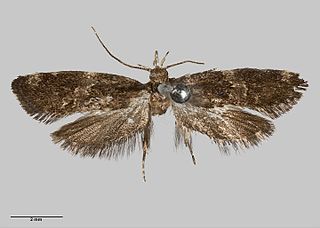
Trachypepla nimbosa is a species of moth in the family Oecophoridae. It is endemic to New Zealand. This species has been collected in Auckland as well as one specimen in the West Coast. Adults are on the wing in January however the West Coast specimen was collected in November. This species is classified as "Data Deficient" by the Department of Conservation.
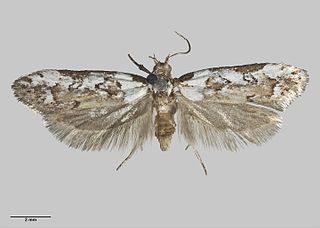
Trachypepla festiva is a moth of the family Oecophoridae and was first described by Alfred Philpott in 1930. It is endemic to New Zealand and has been collected in the northern parts of the North Island.

Tingena hastata is a species of moth in the family Oecophoridae. It is endemic to New Zealand and has been observed in the southern part of the South Island. Adults of this species are on the wing in October.
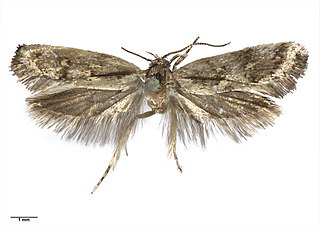
Tingena lassa is a species of moth in the family Oecophoridae. It is endemic to New Zealand and has been observed in Otago. It frequents both subalpine habitat at altitudes up to 1100 meters down to sea level residential areas. This species' resting place on rock walls has frequently been spotted. Around November and December, you can see this species' adults flying.
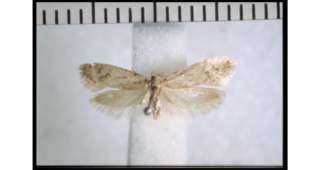
Tingena pallidula is a species of moth in the family Oecophoridae. It is endemic to New Zealand and has been collected in the Nelson and Tasman regions. Adults of this species are on the wing in February and have been collected by beating undergrowth.

Tingena penthalea is a species of moth in the family Oecophoridae. It is endemic to New Zealand and has been observed in Wellington and the Tararua Range. The adults of this species are on the wing from December until February.

Atomotricha isogama is a moth in the family Oecophoridae. It was first described by Edward Meyrick in 1909. This species is endemic to New Zealand and has been observed in the North and South Islands. Larvae are leaf litter feeders and have been recorded as emerging in the New Zealand spring. Adults have been observed on the wing from July to January.

Trachypepla minuta is a moth of the family Oecophoridae first described by Alfred Philpott in 1931. It is endemic to New Zealand and has been collected in Auckland. Adults of this species are on the wing in December. It is distinguishable from similar species as it is smaller in size and darker in appearance than other species in the genus Trachypepla.






















